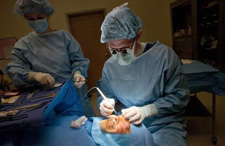Frequently Asked Questions
1. What is Oculoplastics?
Oculoplastics (or oculoplastic surgery) is a sub-specialty within the practice of ophthalmology that addresses the structures that surround the eye: the eyelids, the eye socket, the brows, middle face and the tear drainage system. It is both a medical and a surgical discipline and oculoplastic specialists are surgeons who have completed both a residency in ophthalmology and a fellowship in oculoplastic surgery.
2. Will I need to have surgery for my problem?
It depends. Every new patient has a thorough examination to determine the extent of their problem. The type of problem and the treatment for the best possible outcome is what determines the treatment we will recommend. We will discuss fully the findings and treatment options at your visit.
3. Where do you perform surgery?
We presently use many facilities for surgery services: our office, Intermountain Medical Center in Murray, Utah Surgical Center in West Valley, the Avenues Surgical Center in Salt Lake City, Alta View Medical Center in Sandy, Physician’s Surgery Center in Salt Lake City, Hoopes Vision’s EyeSurg facility in Sandy, and the Zion Eye Institute in St. George. The needs of the particular patient and their insurance coverage will determine which location we choose for a particular procedure.
4. If I need surgery, who will my surgeon be?
Matheson A. Harris, M.D., a board-certified and fellowship-trained ophthalmologist and oculoplastic surgeon.
5. Does insurance cover eyelid surgery?
Frequently insurance carriers and Medicare will cover surgery of the eyelids and brows and almost always of the tear drainage system. Problems like entropion , an abnormal inward turning of the eyelid edge and ectropion, an abnormal outward-turning of the eyelid edge are almost always covered. Abnormal lowering of the eyelid—“ptosis”—and abnormal accumulation of excess and baggy skin in the upper eyelids –“dermatochalasis”-may sometimes be covered, depending on the severity of the problem. Medicare and commercial carriers have specific standards that must be met for the surgery to be covered as a medical problem. If it is not severe enough to be considered a medical problem, then surgery is regarded as cosmetic in nature and is usually not covered by insurers. Surgical removal of excess or baggy skin in the lower eyelids is usually not covered by insurance policies, unless it causes a problem with the function of your eyelid. Click here for a video of Dr. Harris discussing eyelid surgery insurance requirements.
6. If I have a flexible health care spending account, do you accept payment from those?
In most cases we do, please ask. Call us at (801)264-4420.

